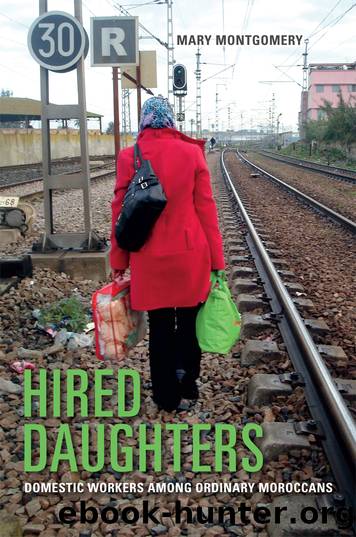Hired Daughters by Mary Montgomery

Author:Mary Montgomery [Montgomery, Mary]
Language: eng
Format: epub
Tags: Social Science, Anthropology, Cultural & Social, Customs & Traditions, Women's Studies, Social Classes & Economic Disparity, Regional Studies
ISBN: 9780253041043
Google: mpmLDwAAQBAJ
Publisher: Indiana University Press
Published: 2019-02-19T05:27:36+00:00
PART II
DOMESTIC WORKERS IN THE WIDER WORLD
5
DOMESTIC WORKERS IN THE CITY
WAGE IN HAND, âNOMADICâ WORKERS EMBODY THE FREE, rational, individual actor choosing whatâs best for herself and appear to lose nothing in the short term by leaving one employer for another. But workers forfeit the long-term stability of being rooted in one place and the promise of a marriage arranged by their patronâa marriage that, in theory, signals the end of working as a domestic and the beginning of life as a full adult. The psychological toll of this rootless albeit independent life surfaces often: homesickness, tiredness, aggression, and an almost frantic search for a husband with whom to make a home. Passing a tree in lâOcéan with a hefty root structure exposed aboveground, Rouqia, who had moved from one house to another numerous times throughout her working life, exclaimed, âLook at this beautiful tree! Look at the roots itâs got. God willing, Iâll be like that. You know, put roots down, have a family and children.â Rouqia had taken the job of finding a husband into her own hands. Her increased mobility, knowledge of the city, and ability to deal with strangers went some way toward equipping her for this while her day off provided her with the freedom to look around.
This chapter takes as its subject the activities of workers on their days off, reflecting aspects of domesticsâ identity as lone female migrants from the countryside and particularly as individuals who have intimate and reproductive aspirations.1 As Mahdavi (2016) argues, this is overlooked by much of the literature on migration, which tends to posit primarily economic forces as explanations for the mobility or immobility of women. I highlight a change for rural Moroccan women from socializing solely with people known to their families and whose families they also know to socializing with people who are unknown. This mirrors the shift, outlined earlier, from working for known employers to working for unknown ones.
Download
This site does not store any files on its server. We only index and link to content provided by other sites. Please contact the content providers to delete copyright contents if any and email us, we'll remove relevant links or contents immediately.
| Biographies | Company Profiles |
| Economic History |
Pale Blue Dot by Carl Sagan(4001)
The Rules Do Not Apply by Ariel Levy(3905)
Goodbye Paradise(2958)
Delivering Happiness by Tony Hsieh(2922)
Liar's Poker by Michael Lewis(2810)
Into Thin Air by Jon Krakauer(2700)
Purple Cow by Seth Godin(2698)
Ogilvy on Advertising by David Ogilvy(2682)
Rogue Trader by Leeson Nick(2472)
The Airbnb Story by Leigh Gallagher(2370)
The Social Psychology of Inequality by Unknown(2309)
The Mind Map Book by Tony Buzan(2080)
Six Billion Shoppers by Porter Erisman(1999)
Bossypants by Tina Fey(1987)
All the President's Men by Carl Bernstein & Bob Woodward(1962)
Claridge's: The Cookbook by Nail Martyn & Erickson Meredith(1962)
Master of the Game by Sidney Sheldon(1881)
Alibaba by Duncan Clark(1755)
Wild Ride by Adam Lashinsky(1658)
